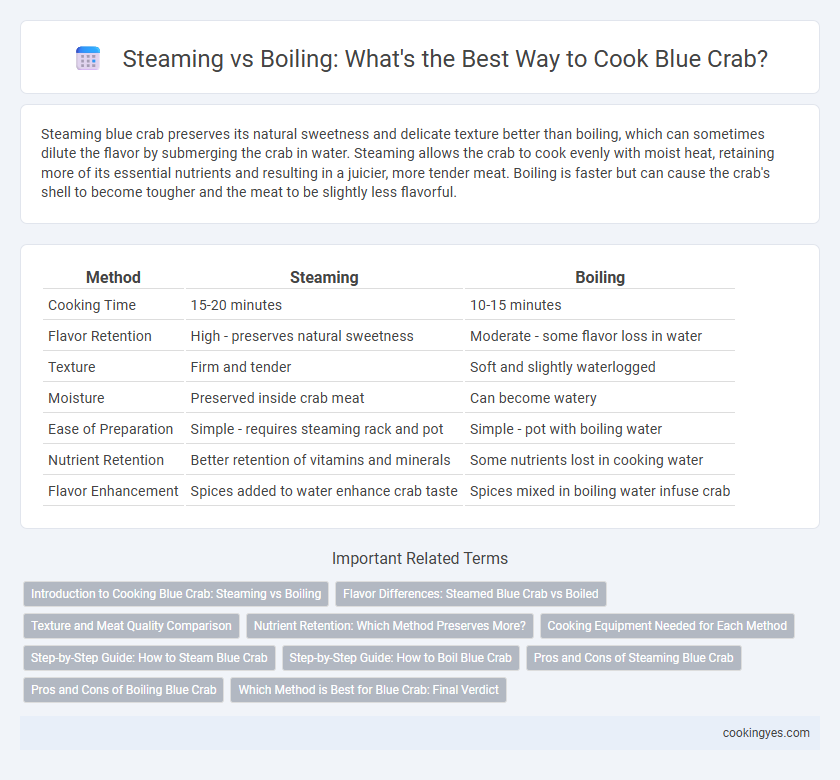Steaming blue crab preserves its natural sweetness and delicate texture better than boiling, which can sometimes dilute the flavor by submerging the crab in water. Steaming allows the crab to cook evenly with moist heat, retaining more of its essential nutrients and resulting in a juicier, more tender meat. Boiling is faster but can cause the crab's shell to become tougher and the meat to be slightly less flavorful.
Table of Comparison
| Method | Steaming | Boiling |
|---|---|---|
| Cooking Time | 15-20 minutes | 10-15 minutes |
| Flavor Retention | High - preserves natural sweetness | Moderate - some flavor loss in water |
| Texture | Firm and tender | Soft and slightly waterlogged |
| Moisture | Preserved inside crab meat | Can become watery |
| Ease of Preparation | Simple - requires steaming rack and pot | Simple - pot with boiling water |
| Nutrient Retention | Better retention of vitamins and minerals | Some nutrients lost in cooking water |
| Flavor Enhancement | Spices added to water enhance crab taste | Spices mixed in boiling water infuse crab |
Introduction to Cooking Blue Crab: Steaming vs Boiling
Steaming blue crab preserves its natural sweetness and tenderness by cooking it gently with minimal water contact, enhancing flavor and texture. Boiling blue crab submerges it in rapidly boiling water, resulting in a quicker cook time but potentially diluting the crab's delicate taste. Both methods require precise timing to ensure the blue crab meat remains moist and succulent without becoming tough.
Flavor Differences: Steamed Blue Crab vs Boiled
Steaming blue crab preserves its natural sweetness and tender texture by minimizing water absorption, resulting in a more concentrated flavor profile and firmer meat. Boiling blue crab infuses the shell and meat with seasoning from the cooking liquid, which can enhance savory notes but may dilute the crab's inherent taste and soften the texture. Choosing steaming emphasizes the crab's delicate, oceanic essence, while boiling creates a bolder, seasoned flavor ideal for spiced or heavily seasoned preparations.
Texture and Meat Quality Comparison
Steaming blue crab preserves its natural texture by allowing the meat to cook evenly without absorbing excess water, resulting in a firmer and sweeter flavor. Boiling can cause the meat to become waterlogged and less flavorful, often leading to a softer, mushier texture. Steamed blue crab retains its firmness and delicate taste, making it the preferred method for maintaining optimal meat quality.
Nutrient Retention: Which Method Preserves More?
Steaming blue crab preserves more nutrients compared to boiling by minimizing direct contact with water, which reduces the leaching of water-soluble vitamins and minerals such as B vitamins and zinc. The gentler heat and shorter cooking time in steaming help maintain the crab's natural moisture and flavor while retaining key antioxidants and omega-3 fatty acids. Boiling often causes nutrient loss through prolonged immersion in water, leading to diminished nutritional value in the final dish.
Cooking Equipment Needed for Each Method
Steaming blue crab requires a large pot with a steaming rack or basket to keep crabs elevated above boiling water, ensuring even heat distribution and preserving delicate flavors. Boiling blue crab involves a deep pot filled with enough water to fully submerge the crabs, along with a strainer or slotted spoon for easy removal. Both methods benefit from heavy-duty cookware such as stainless steel or enameled pots to handle high temperatures and avoid reaction with seasoning ingredients.
Step-by-Step Guide: How to Steam Blue Crab
To steam blue crab, bring a few inches of water, vinegar, and seasoned salt to a boil in a large pot with a steaming rack. Place the crabs on the rack, cover the pot, and steam for 20-25 minutes until the shells turn bright red. This method preserves the crab's natural juices and enhances its sweet, delicate flavor compared to boiling.
Step-by-Step Guide: How to Boil Blue Crab
Boiling blue crab requires bringing a large pot of salted water to a rolling boil, often seasoned with Old Bay seasoning or sea salt for enhanced flavor. Add live crabs carefully to the boiling water, ensuring they are fully submerged, and cook for 12-15 minutes until the shells turn bright orange-red. Remove the crabs with tongs and let them drain before serving to preserve the sweet, tender meat inside.
Pros and Cons of Steaming Blue Crab
Steaming blue crab preserves the natural sweetness and tender texture by cooking the crab without submerging it in water, which prevents dilution of flavor and loss of nutrients. This method allows the seasoning to penetrate more effectively, enhancing taste, but it requires careful monitoring to avoid overcooking, which can toughen the meat. However, steaming can take longer than boiling and may not be ideal for larger quantities due to time and space constraints.
Pros and Cons of Boiling Blue Crab
Boiling blue crab offers the advantage of quick, even cooking, ensuring the meat is tender and fully cooked through the shell. However, boiling can cause some loss of flavor and nutrients into the water, resulting in a less intense crab taste compared to steaming. It also tends to make the shells slightly more brittle, which may affect the ease of cracking the crab legs and claws.
Which Method is Best for Blue Crab: Final Verdict
Steaming preserves the natural sweetness and tenderness of blue crab by preventing flavor loss in cooking water, making it the preferred method for many seafood enthusiasts. Boiling can sometimes dilute the crab's delicate taste and texture as the meat absorbs water and seasoning from the pot. For optimal flavor and juiciness, steaming blue crab is generally considered the best cooking technique.
Steaming vs boiling for blue crab Infographic

 cookingyes.com
cookingyes.com